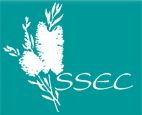Botany Bay National Park |

Botany Bay National Park
Photo: Daphne Salt
|
Botany Bay National Park is located on the eastern end of the Kurnell Peninsula and covers an area of 324 hectares. The Park is managed by NSW National Parks and Wildlife Service and provides protection to a rich diversity of environments and ecosystems including cliffs and rock platforms, dunes, freshwater streams and swamps, and wet forest which all support a range of fauna species, many of them endangered.
Cliffs and Rock Platforms
The eastern boundary the Park features spectacular cliffs. The cliffs are exposed Hawkesbury sandstone with narrow gorges at Yena Gap and Tabbigai. |
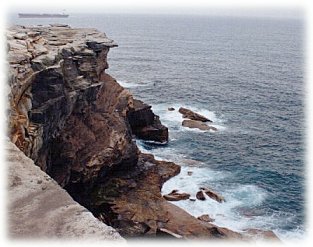
Hawkesbury sandstone cliffs at Cape Solander (also below) |
| The cliffs reach up to 40m above sea level and provide an ideal location for whale spotting during the whale-watching season. (See marine for more details). |
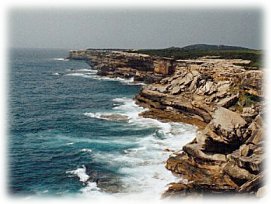 |
Dunes
A major feature of the Park is the widespread aeolian (wind blown) and alluvial sands. In some areas of the Park the dunes are up to 20m. At the southern of the Park sand dunes have been deposited in a North-South orientation. The largest dune in the Park is Botany Cone which is one of the largest coastal dunes remaining in the Sydney region. |

Dunes near Potter Point
Photo: Daphne Salt |
Threats to the integrity of the dunes come from 4WD and motor bike use and horse-riding activities. This strips the dunes of vegetation and makes them more susceptible to erosion and blowouts, one of which can be seen to the right of the photo.
Freshwater Streams
The most important freshwater stream among many in the Park is one which rises near the Discovery Centre and flows into Botany Bay adjacent to Alpha Farm. The stream (below) was utilised by Aborigines and provided freshwater to the crew of the Endeavour. |
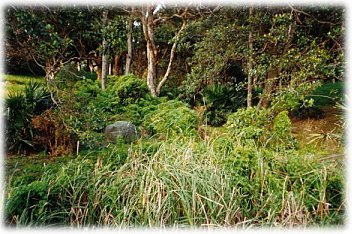 |
Freshwater streams and hanging swamps provide habitat for eastern long-necked tortoise and Green and Golden Bell Frog.
Natural Vegetation
The Park contains remnant vegetation which would have been observed and collected by Banks and Solander in 1770. It is therefore not only of ecological importance but historical as well.
Despite the fact that much of the vegetation has been cleared, a few species remain including bangalays, swamp oak, cabbage-tree palms and broad-leaved paperbark. The Park also contains heath dominated by old man banksia, she oak and grass tree. |
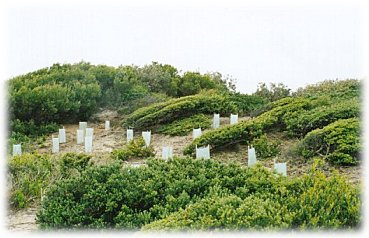
Heath vegetation in the National Park. Here bush regeneration by volunteers and NPWS staff helps stabilise the dunes. |
| Swamp and wetland species, schlerophyll woodland (eucalypt, acacia, casuarina) and small pockets of wet forest (below) also contribute to the Park's biodiversity. |
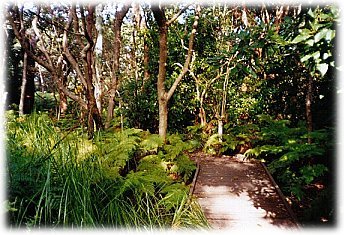 |
Amongst the rare plants, syzygium paniculatum and the Botany Bay Bearded Greenhood Orchid are most noteworthy. The syzygium is included in the Sutherland Shire Littoral Rainforest which has been listed as an Endangered Ecological Community under the NSW Threatened Species Conservation Act.
In October 2000, approximately 100ha of the National Park was burnt in a bushfire which was believed to be started by an illegal fireworks display outside the Park. At one stage the fire threatened the nearby Caltex Oil Refinery. Four helicopters and over 100 fire fighters were required to bring the fire under control. Fauna
About 96 bird species have been recorded in the Park including the Japanese Snipe, whimbrel, red-necked stint, superb fairy wren.
Click here for a species list for the Park.
Other fauna in the Park include the brush-tailed possum, flying foxes, brown snakes and red-bellied black snakes. Eastern long necked tortoise has also been sighted as has the Green and Golden Bell Frog and the threatened tinkling froglet.
Other Features of the Park
A significant feature is Captain Cook's Landing Place where Cook and his crew first set foot on Australian soil in 1770.
In 1870, Thomas Holt erected a monument to celebrate the centenary. |
 |
The Park is also the location of Captain Cook's Landing Place where first contact between Europeans and indigenous peoples took place. The Park is thus rich in cultural sites and historic places.
Education
Within the National Park is the Discovery Centre (below) which provides a centre for interpretation and education on many of the features of the Reserve and contains displays and educational material on ecosystems and on the historic nature of the Park. |
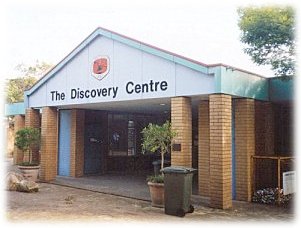 |
The Park is also site of the Botany Bay Field Studies Centre which is run by the Department of Education.
The Study Centre staff accompany students on tours of the Park, and of significant areas of the Kurnell Peninsula including the internationally significant wetlands of Towra Point Nature Reserve.
Walking Tracks
There are a number of walking tracks in the Reserve including the Banks-Solander (below), Yena, Cape Baily and Muru Tracks. |
 |
A new Draft Plan of Management for the Reserve was released by National Parks and Wildlife Service in February 2000. NPWS have indicated that the Plan will promote management that will
- Make the Park a significant place for all Australians
- Develop the theme of 'meeting place'
- Provide a venue for the recognition of Aboriginal culture
- Protect ecological/environmental values
- Conserve historic features
- Promote historic management of the Park
Aboriginal Heritage
There is significant evidence of Aboriginal occupation in the Park including middens, burial sites, artefacts, scatters and at least 2 engravings of fish and footprints. National Parks and Wildlife Service has identified that the Park has the potential to act in a 'keeping place' role as a secure area which can be used for the storage or return of cultural material. Discussions on this issue are ongoing.
More information on the Park, including the Plan of Management for the Park, can be found in the Botany Bay National Park section of the NPWS website here. |
| top of page |
